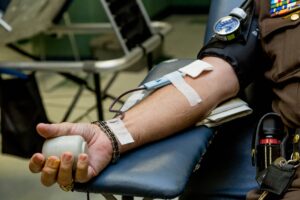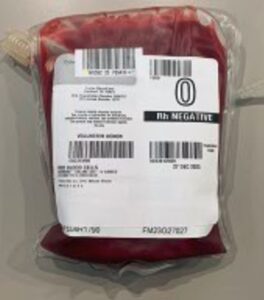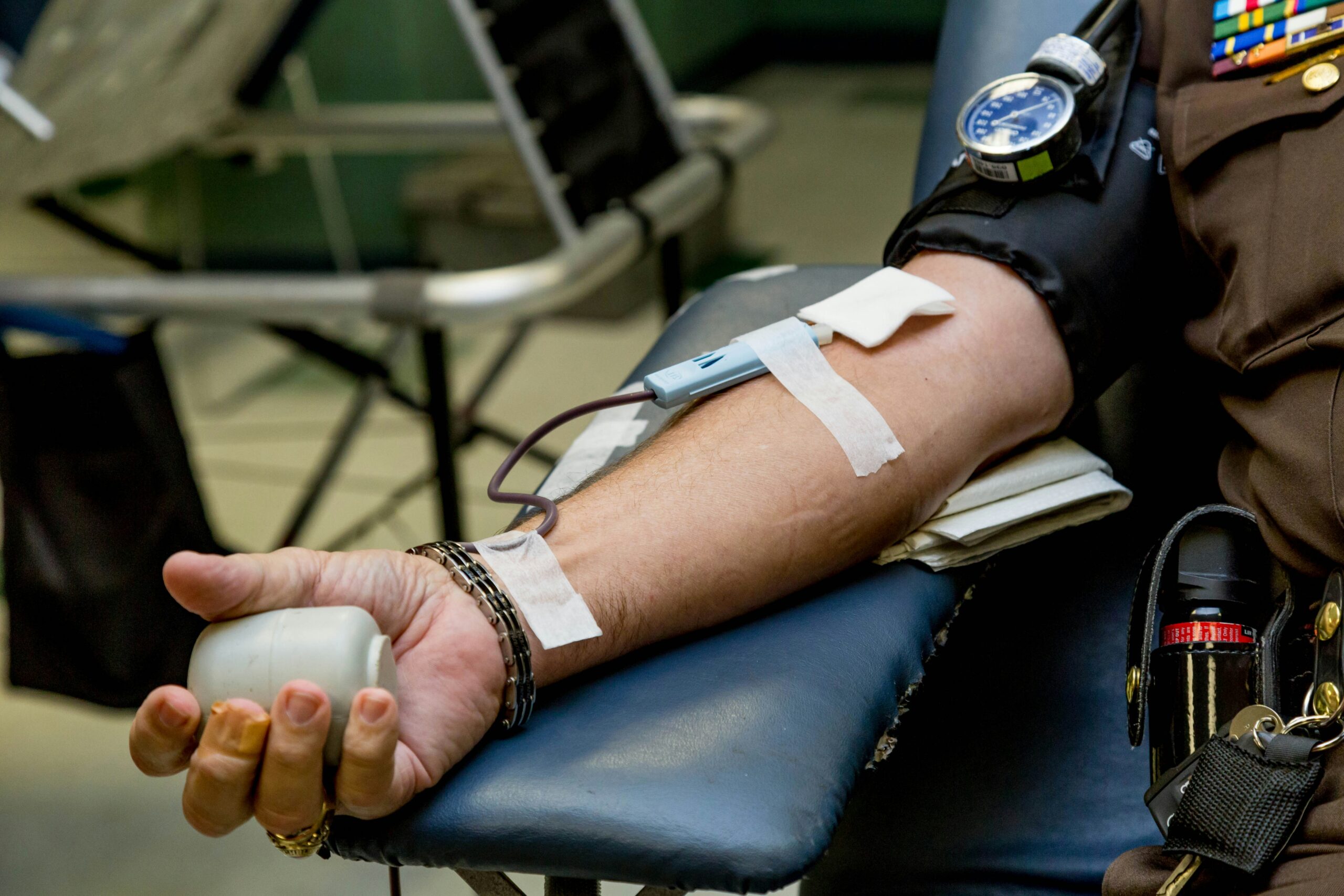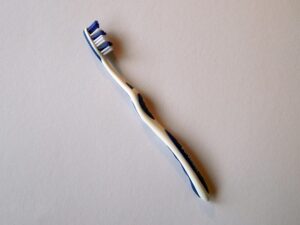
According to the Red Cross, 29,000 units of red blood cells are needed for transfusion every day in the U.S. In order to keep up with this tall order, blood drives must be conducted every single day. Some of the most successful blood drives that take place are led by a host within an organization like a school or workplace.
Hosting a blood drive is a great way to serve your community. A blood drive host is somebody who works with a blood donor center to organize a blood drive in order to collect units of blood, typically red blood cells, for their local hospitals and community. As the supervisor of a blood donor center in Texas, I have worked with many people who wanted to host a blood drive for their respective organizations, and I’ve collected many insights into aspects which proved successful for these blood drives. If you want to learn how to host a blood drive, read below so that you can understand the process and the many moving parts that are involved.
Where Is A Blood Drive Located?
The host will be responsible for determining a suitable location and reserving it for the drive. They should reserve a space which is large enough to setup the blood drive equipment and hold the estimated amount of people involved, including donors and blood drive staff. There are 3 main types of locations which are typically used:
On-Site: If the host has available space at their organization’s location, it can be held “on-site”. Good locations include places like conference rooms, auditoriums, classrooms and foyers/entrances. The benefit to an on-site drive is that it is close to the host’s organization, hence making it more accessible for potential donors. The drawback is that the donor center has to transport their equipment and set it up, adding time to the setup and teardown process.
BDC: sometimes the Blood Donor Center will offer up their own building as a location if the host doesn’t have sufficient space available. The benefit to a BDC drive is that the donor center staff’s setup is minimal since their equipment is already in place. However, a huge drawback is that the BDC may be far away from the host’s organization, making it less accessible for potential donors, which makes them less likely to donate due to the extra effort and time required.
MBU: The Mobile Blood Unit (MBU) is a huge RV-like vehicle which has the blood donor center’s equipment already installed. It is normally loaded up with supplies at the donor center before it is driven to a host site and parked. A benefit to using an MBU is that the donor center staff doesn’t need to move equipment back and forth and do set-up and teardown since it is already setup inside of the MBU. Another benefit is that since it is mobile, it has the flexibility to be driven around and moved as necessary. Also, since it can be parked close to the host’s site, it remains accessible to prospective donors, which increases the likelihood of them donating. A drawback to the MBU is that the throughput is drastically reduced since it is a much tighter space, usually only allowing space for 4 or 5 beds. For example, if an on-site or BDC blood drive can push out 25 to 30 donors per hour, an MBU may only be able to push out 8 to 12 per hour.
How To Find Volunteers To Donate Blood
A blood drive is worthless unless volunteers actually show up to donate. This is why recruiting is the most important task that a host will be responsible for. Here are some ideas which a host can use to attract prospective donors to a drive:
Flyers: These can be posted in high traffic areas like entrances, cafeterias, bulletin boards and restrooms, just to name a few. Make sure you have the date/time and location listed so that they know where to be at the right time.
Email: This is usually more applicable to work emails since private emails have more potential privacy policy issues. An email has the widest potential reach since everybody checks their email and it is likely to reach people who don’t frequent the areas that you have posted flyers. Try to make the message come from an internal email address of the organization to avoid the potential of it getting filtered out as spam. Ensure to get approval from the appropriate supervisor as well.
Word of Mouth: Advertising for a blood drive by word of mouth is by far the most effective method, especially if the host is a well-liked and respected person within that organization. When somebody asks for their donation face-to-face, it’s a lot harder to blow off, than a faceless marketing flyer or email. The power of a genuine human connection is hard to replace and can be the small spark which motivates a person to take valuable time out of their day to come donate.
Everybody should be welcomed to donate, however, special emphasis should be placed on those who are type O, since this is the most commonly transfused blood type. Recruiting a higher proportion of type O donors can reduce wastage from collecting less needed blood types that will expire on the shelf without ever being used due to the lower demand. The bright side of this is that these A, B and AB donors can still be used by the donor center, just in a different way. Instead of collecting red blood cells from them at a blood, these donors are actually more useful as plasma donors, which are scheduled by appointment on an individual basis.
How To Schedule Blood Donors For A Drive
Scheduling is another task which is the responsibility of the blood drive host. Efficiency is the key since it will prevent backlogs and long lines which can deter prospective donors from showing up or can keep them from leaving early if they get stuck waiting in line.
What you don’t want to do is to have everybody show up at the beginning of the drive. This is because the donor center staff can only push out a certain number of donors per hour, usually determined by how many beds are set up. Having everybody show up at once will overwhelm the donor center’s resources, causing long lines and frustration.
The more ideal way to schedule your donors is to stagger them according to the hourly throughput. If they can push through 30 donors an hour, then have 30 time slots on your sign-in sheet for every hour. Once you hit 30 names, put any additional names after that into the 30 slots for the next hour. Work with the donor center supervisor to determine how many donors you should schedule per hour.
Depending on which donor center you are hosting for, they may want you to pre-screen prospective donors to reduce the number of unqualified donors that may show up. This may consist of showing them a list of common disqualifiers and making sure they answer no to everything to increase the chance that they will be fully qualified after undergoing the interview process during the drive. The more unqualified donors that can be pre-screened out ahead of time, the better. This will help improve the donor to deferral ratio and improve efficiency.
What Are Some Common Incentives for Blood Donors?
Many blood donors donate out of the goodness of their heart. However, some donors need a bit of an extra nudge to help them make the decision to donate. Here are some of the more common incentives which the donor center and host organization can allow in order to motivate prospective donors:
Time Off: organizations can grant time off for those that sacrifice their time to donate. In fact, government civilians (GS employees) can be granted up to 4 hours of administrative leave for each donation.
Merchandise: normally, once a donor has completed their donation, they can receive some sort of donor incentive merchandise which is provided by the donor center. This can be a t-shirt, hoodie, coffee mug, tumbler or a number of other items. The donor center will often advertise themselves on the merchandise to increase awareness of their facility and the blood donor mission.
Patient Impact: The whole purpose of donating blood is so that it can one day be transfused to a patient in need. If you have a personal story of how blood products saved the life of somebody close to you or in the community, this can go a long way towards motivating somebody so that they understand the impact of their donation on potentially saving a life.
What Is The Blood Donor Center Responsible For?
The host has their list of duties and responsibilities, but so does the donor center. The donor center will assign a representative to assist the host and will serve as the subject matter expert for any donor operation related questions.
Donor centers will let the host know their requirements such as location needs, throughput capabilities and total number of donors per day. The donor center rep will help the host by offering feedback during the planning phase, offering recruiting tools to help attract donors and provide equipment, supplies and trained staff to safely collect the blood units. The donor center will also provide snacks, drinks and donor incentive merchandise for all donors that make it all the way through the blood collection process.
Before The Blood Drive
The planning phase sets the foundation for a successful blood drive. Your donor center point of contact can guide you along the way. Here are some things to focus on while planning a blood drive:
-Check with senior leadership and management to ensure that they approve of a blood drive, especially if it will take place at the company location and/or on company time. The last thing you want is to have your drive shut down the day of because management wasn’t tracking the event in the first place.
-Secure a date and time that is far out enough for the organization to plan around. Also, make sure that the drive is not at the same time as a holiday or a special event since the interference can cause donors to not be available.
-Figure out a location far in advance so you can determine what you’ll need to reserve. Depending on the location, you may need to reserve the area a few months out.
-Determine your target number of donors. This will depend on the size of the organization and the location restraints since donating blood is a numbers game. If it’s a quick MBU drive, the goal may only be 15-20 units. If it’s a large multi-day on-site drive like the annual West Point blood drive, the goal may be close to 1,000 units.
-Recruit donors utilizing the above marketing methods. If you can find some helpers to assist you, even better. Recruit more donors than your actual goal is, because it all reality, some of them will not make it through the screening process. For example, if your target is 50 donors, you may want to have 60-75 donors show up. Because depending on the demographics of the organization, 20-30% or so of them may get deemed ineligible to complete the donation process, due to medical history, travel history, vitals, among other things.
-Coordinate donor incentives. Even though the donor center may already have incentives lined up, it wouldn’t hurt to have some extra incentives as icing on the cake. Maybe you have access to some select resources that are hard to come by and would be seen as value in the eyes of the donor.
The Day Of The Blood Drive
Get to the site early to greet the donor center staff and orient them to the pertinent locations of the blood drive area. They will normally arrive 2 hours prior to the start time in order to begin setting up.
Remain accessible throughout the drive in case the donor staff needs assistance with any PR, logistics or facilities issues if they arise. Make sure to have a list of phone numbers for important points of contact in various departments if you need to get a hold of somebody quickly in a pinch.
Track donors as they sign in for their scheduled time and make phone calls to remind them of their appointment if necessary.
Supervise any volunteers that you may have assisting with the drive. Tasks like sign-in/registration, managing donor flow, manning the refreshments area and handing out donor incentive merchandise usually need an extra hand.
Keep an eye out for any donor reactions that may occur. Sometimes, donors will feel lightheaded and nauseous and may even pass out. This normally happens while they are in the chair still donating. But it also happens frequently in the refreshments room after they’ve already donated. The refreshments room may be out of sight of the donor center staff. Thus, it’s a good idea for you or your helpers to remain observant so you can alert donor staff of any reactions so they can perform the proper steps to handle it. They may ask for help lifting donors off of the ground onto a bed, so use good lifting technique if you are physically able to do so.

After The Blood Drive
Gather stats from the drive like how many people were screened and how many actually donated. Compare this number to any prior blood drives to analyze trends and see what things may have improved or decreased performance from the last time.
Send a thank you note to donors to thank them for their donation. This lets them know that their time and selflessness is appreciated, and it can also serve as a reminder of the donor center’s contact info in case they would like to donate again. Make sure the contact info you have on hand is accurate.
Give feedback to the donor center supervisor to let them know of any sustains and improves that you noticed during the drive. Tactfully, give your opinion about anything that you feel didn’t go well and could be improved next time. Each blood drive is unique and may require a different approach than others.
Quick Checklist For Hosting A Blood Drive
Before The Drive
-Get permission from leadership
-Link up with a blood donor center in your area
-Determine a target goal of units collected
-Set a date and time with minimal to no time conflicts
-Determine a suitable location
-Advertise the blood drive and recruit donors
-Schedule any prospective donors
-Conduct a walkthrough of the location
-Coordinate for donor incentive merchandise
The Day of the Blood Drive
-Get to the site at least 2 hours early
-Remain accessible throughout the drive
-Track donors as they sign in
-Make phone calls to no-show donors to check their status
-Supervise your helpers
-Ensure the refreshments area stays stocked up
-Alert donor staff of any donor reactions you witness
After the Blood Drive
-Gather stats from the drive
-Give feedback to the donor center supervisor
-Send a thank you note to donors
Which Donor Centers Can You Volunteer With?
Once you decide that you want to host a blood drive and have got it approved by leadership, you’ll need to link up with a donor center in your area who will serve as your advisor and will be the ones to come out and conduct the drive. The Red Cross has the widest span and can be found in most areas of the United States. There are also smaller regional donor center networks which operate in specific areas of the country. Here is a list of some of the biggest donor center chains in the country:
Red Cross: with a whopping 366 donor centers across 39 states and District of Columbia, the Red Cross is the most recognized name in the blood donation business.
Vitalant: has 115 donation locations from coast to coast, and blood donation centers in 20 states including Arizona, California, Colorado, Idaho, Illinois, Louisiana, Mississippi, Montana, Nevada, New Jersey, New Mexico, North Dakota, Ohio, Pennsylvania, South Dakota, Tennessee, Texas, Washington, West Virginia and Wyoming.
Lifesouth: has 51 donor centers that serve more than 150 hospitals in Alabama, Florida, Georgia and Tennessee.
Versiti: has nearly 50 donor centers across Illinois, Indiana, Michigan, Ohio and Wisconsin.
Impact Life: has 23 donation locations throughout Iowa, Illinois, Missouri and Wisconsin.
Lifeserve: has 14 donor centers that serve 161 hospitals primarily in Iowa, Nebraska and South Dakota.
Bloodworks: has 12 donor centers in Oregon and Washington State that serve more than 90 regional hospitals in the Pacific Northwest.
Lifeshare: has 9 donor centers that serve 100 medical facilities and hospitals throughout Louisiana, East Texas and South Arkansas.
WeAreBlood.org: has 4 donor centers in the Austin area which serves over 40 medical facilities in a 10-county region located in central TX.
How Hosting A Blood Drive Can Impact Your Community
Hosting a blood drive is a lot of work to plan and execute. But it will pay off in a big way within your community. The blood that is collected that day will likely go to one of the hospitals in your local area. It can help save the lives of strangers, family, friends and maybe even yourself when the need arises. Hosting a blood drive that collects 50 units, can result in up to 50 lives being saved.
If you are interested in hosting a blood drive at your school, work or other organization, contact your nearest blood donor center to begin the process.











